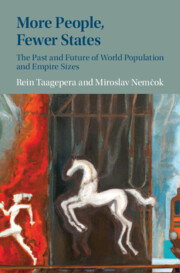Book contents
- More People, Fewer States
- More People, Fewer States
- Copyright page
- Contents
- Figures
- Tables
- Preface
- 1 More People and Yet Fewer States
- Part I World Population Growth
- Part II Empire Growth
- 4 From Populations to Empires and the Role of Technology
- 5 Empires
- 6 Talkers, Doers, Regulators, and Followers
- 7 From Pecking Order to Political Order
- 8 Runner Empires (−3000 to −600)
- 9 Early Rider Empires (−600 to +600)
- 10 An Apparent Dead End
- 11 Stirrup Empires (600 to 1200)
- 12 The Last Rider Empires (1200 to 1800)
- 13 Engineer Empires (From 1800 Onward)
- Part III Trends and Interactions
- Book Appendix: Chronological Table of Major State Sizes, −3500 to +2025
- References
- Index
10 - An Apparent Dead End
Republics
from Part II - Empire Growth
Published online by Cambridge University Press: 21 June 2024
- More People, Fewer States
- More People, Fewer States
- Copyright page
- Contents
- Figures
- Tables
- Preface
- 1 More People and Yet Fewer States
- Part I World Population Growth
- Part II Empire Growth
- 4 From Populations to Empires and the Role of Technology
- 5 Empires
- 6 Talkers, Doers, Regulators, and Followers
- 7 From Pecking Order to Political Order
- 8 Runner Empires (−3000 to −600)
- 9 Early Rider Empires (−600 to +600)
- 10 An Apparent Dead End
- 11 Stirrup Empires (600 to 1200)
- 12 The Last Rider Empires (1200 to 1800)
- 13 Engineer Empires (From 1800 Onward)
- Part III Trends and Interactions
- Book Appendix: Chronological Table of Major State Sizes, −3500 to +2025
- References
- Index
Summary
Polyarchies (rule of the many) require more social and political skills than monarchies (rule of one) and hence arose later – from monarchies rather than directly from tribes. Carthage, some Greek city-states, and early Rome are almost the only ancient republics. All were at or near the Mediterranean coast. These republics mostly were oligarchies (rule of the few), but even democracies meant rule of the many but not all: Slaves and free noncitizens often outnumbered citizen families. The Greek states, monarchies or republics, formed a mutual fighting community, often vicious. Republics depended on a committed citizenship and faced a size trap. If they remained small, they remained vulnerable externally. If they expanded, they lacked mechanisms to include subdued people as citizens and became fragile internally. Only Carthage and Rome attempted major expansion, and only Rome succeeded, but this was the end of the republic. It may also be the peak of chattel slavery in world history: Soon three out of seven million people in Italy were slaves. By the year 1, republics looked like evolutionary dead ends. Monarchies, hereditary or not, prevailed.
Keywords
- Type
- Chapter
- Information
- More People, Fewer StatesThe Past and Future of World Population and Empire Sizes, pp. 149 - 160Publisher: Cambridge University PressPrint publication year: 2024

